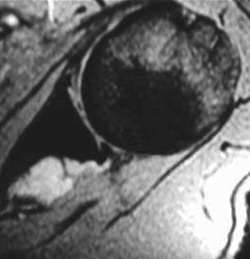Instability imaging: Orthopedists should read films before the radiologist reports
Investigator notes MRI with gadolinium enhancement is the gold standard for assessing the glenoid.
KOHALA COAST, Hawaii — Orthopedic surgeons should always interpret their own imaging studies and not rely solely on radiologist reports, according to a New York upper extremity specialist.
“We really need to fully evaluate all of our imaging studies,” William N. Levine, MD, said at Orthopedics Today Hawaii 2010, here. “If we do that well, we can minimize the likelihood of failure.”
Levine, the sports medicine section chair for the meeting, said that orthopedic shoulder specialists should be familiar with the studies they will use most for assessing instability: plain radiographs, CT scans, MRI and especially MRI arthrograms, which are the gold standard.
“The plain films give us a lot of information in instability surgery,” he said. “We can use the specialized films when looking at the glenoid and trying to identify and rule out problems. But in most patients, we are going to order an MRI with gadolinium enhancement.”
|
Image: Levine WN |
Plain film
Important X-ray studies to order for instability include: true AP, outlet views and, most importantly, axillary views. “We need these to determine when we start to lose significant bone in that anterior-inferior aspect of the glenoid,” he said. “There, we shift the discussion from open versus arthroscopic to bone versus soft tissue.”
To assess bony lesions of the glenoid, surgeons need apical oblique and West Point views. To assess for Hill-Sachs lesions in the humerus, surgeons will need Stryker notch and AP in internal rotation views.
MRI
For MRIs, surgeons have to become comfortable with the coronal oblique, sagittal oblique and axial views, Levine said.
“When assessing the labrum in the coronal oblique view, note that gaps seen below the equator will be pathologic,” he said. “In an MRI arthrogram, in the posterior labrum you should never see dye between the posterior labrum and the bone.”
Levine noted the variability that can be seen in the anterior/superior quadrant in MRIs, and the fact that sometimes labral tears on MRI reports are in fact a sub-labral foramen or a Buford complex.
“We need to know the anatomy, the pathology and the normal variants,” he said.
Subscapularis tears are missed a lot on radiologist reports. “This is very important in patients who have had a traumatic injury after an instability surgery — the labrum may be intact, but they may have torn their subscapularis,” he said.
CT scans
He said CT scans are useful for assessing glenoid bone loss and posterior instability, especially 3-D reconstructions if they are available.
“Use CT scans for any cases where you may be suspicious of bony injury or in revisions of failed prior surgeries,” he said.
Levine said orthopedists should not read radiologist reports until after they have interpreted their own films to avoid being biased. “Radiologists are consultants,” he reported. – by Lee Beadling
Reference:
- Levine WN. Imaging in instability. Presented at Orthopedics Today Hawaii 2010. Jan. 10-13, 2010. Kohala Coast, Hawaii.
- William N. Levine, MD, professor of orthopedic surgery and chief of sports medicine, can be reached at Columbia at New York-Presbyterian Hospital, 622 West 168th St., PH 11, New York, NY, 10032; 212-305-0762.; e-mail: wnl1@columbia.edu.

